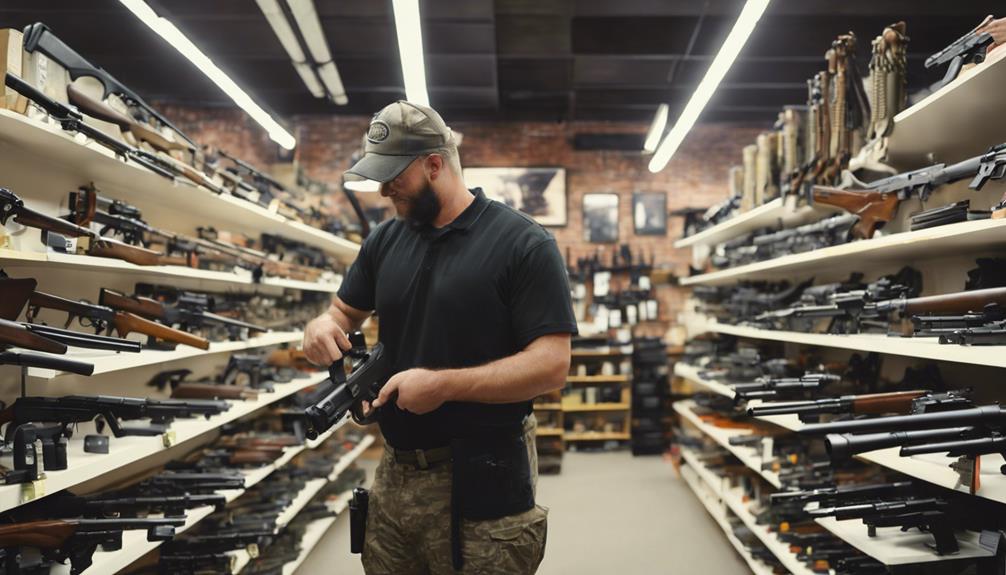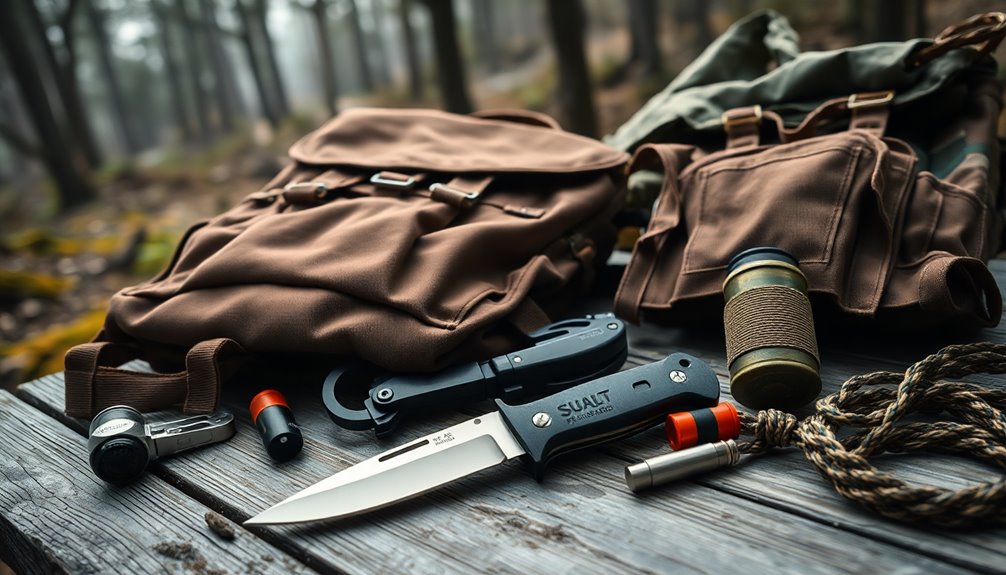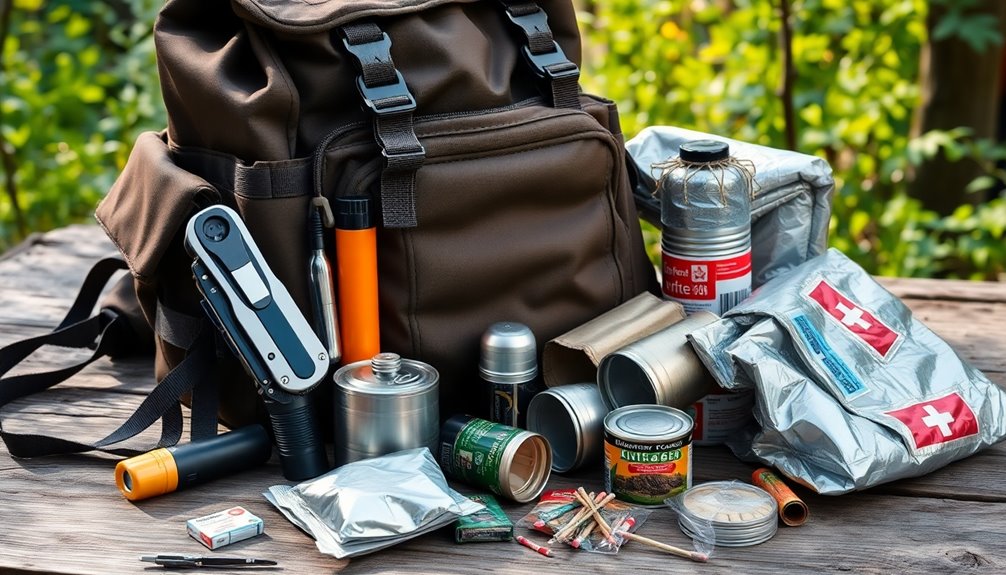When packing your bug-out bag, start with essential clothing like moisture-wicking layers, a sturdy jacket, and durable pants. Make certain to include water supplies, like a reliable container and purification methods. Don't forget lightweight, non-perishable food options such as dehydrated meals and energy bars. Pack an extensive first aid kit and necessary hygiene items to stay healthy. Include shelter essentials like a sleeping bag and tarp. Add communication devices, personal safety gear, and a multi-tool for versatility. These items are vital for your safety and survival. Discover more essential items to guarantee you're fully prepared.
Key Takeaways
- Include essential clothing layers, footwear, and personal safety gear to protect against varying weather conditions and ensure personal safety.
- Pack at least 3 liters of water storage options and water purification methods to stay hydrated during emergencies.
- Bring a variety of lightweight, non-perishable food items and portable cooking supplies for sustained energy and nutrition.
- Include survival gear like multi-tools, first aid supplies, and lighting options to address various emergency situations effectively.
- Equip your bag with communication tools and signaling devices to maintain contact and ensure visibility during emergencies.
Essential Clothing Items
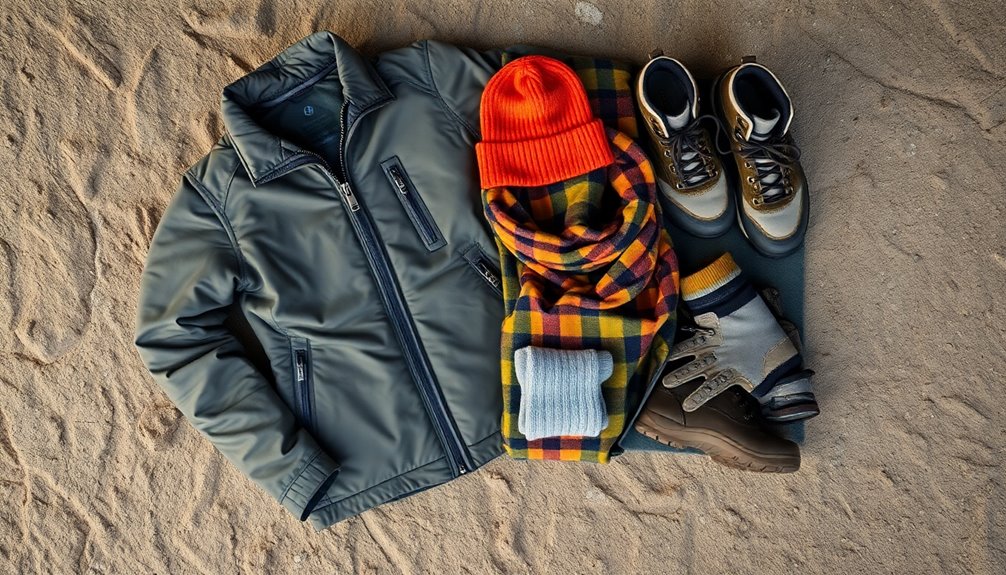
When packing your bug-out bag, essential clothing items play a crucial role in guaranteeing your comfort and survival. Start with headgear like a watch cap, baseball hat, or bandana to protect against the sun or cold. For your upper body, layer up with long underwear shirts for chilly weather, followed by a wool sweater, a light inner jacket, and a heavier water-resistant outer jacket. Don't forget a rain jacket with a hood and a camouflage poncho for wind and rain protection.
For your lower body, pack moisture-wicking inner socks, durable jeans or work pants, and water-resistant pants. Include extra pairs of pants and a silk-weight base layer for varying conditions. You'll need comfortable hiking boots and water socks for wet terrains, along with a heavy-duty belt to hold everything together.
Versatility is key; choose clothing made from natural fibers like cotton, wool, or denim. Opt for dark, subdued colors to avoid attracting attention. Additionally, ensure your clothing can handle prolonged exposure to elements, as this may lead to serious health risks. Finally, pack multiple pairs of socks and undergarments for hygiene, plus clothes clips to hang wet items. Guarantee all clothing is comfortable for long-distance walking, so you can stay focused on your survival.
Water and Hydration Supplies

When packing your bug-out bag, water and hydration supplies are vital for survival. You'll need essential containers to store and carry water, as well as effective purification methods to guarantee it's safe to drink. Let's explore the best options for both water storage and purification so you can stay hydrated on the go. One great choice to consider is the Water B.O.S.S.- Bug Out Survival Supplement, which includes 30 essential items for water collection and purification.
Essential Water Containers
Choosing the right water containers is essential for any bug-out bag, as they directly impact your hydration strategy in emergencies. You should include a variety of containers to store at least 3 liters of water per person for 72 hours. Distributing water in multiple containers allows for flexibility and easier access. Aim for both a rigid container, like a Nalgene bottle, and a collapsible option, such as a Platypus water bag. It's important to remember that preparation for unpredictable events minimizes risks during crises and ensures you have adequate hydration.
Here's a quick overview of container choices:
| Container Type | Features |
|---|---|
| Nalgene Bottle | Durable, wide-mouth opening |
| Metal Canteen | Rugged, can boil water |
| Collapsible Water Bag | Lightweight, saves space |
| Hydration Bladder | Easily accessible during activity |
| Stainless Steel Bottle | Insulates, minimizes taste transfer |
When selecting containers, opt for those made from durable materials that can withstand various conditions. Confirm they're easy to fill and carry, and consider multi-use functionalities whenever possible. This way, you'll stay hydrated and prepared, no matter the situation.
Purification Methods Explained
To guarantee safe drinking water in emergencies, understanding various purification methods is essential. Here are some effective techniques you should consider for your bug-out bag:
- Water Filtration Systems: Compact options like the Katadyn Hiker Pro and Sawyer Mini filter out harmful bacteria and protozoa, ensuring clean water. Additionally, consider the Puribag for its portable water purification solution, which is designed for easy transport and use in various environments.
- Chemical Purification: Use P&G Water Treatment Packets or Katadyn MP1 tablets for rapid disinfection, effectively removing pathogens.
- Boiling: Simply boil water for at least one minute to kill viruses, bacteria, and protozoa. This method is reliable, but you'll need fuel and time.
- Miscellaneous Methods: Consider pre-filtration with bandannas or socks before using other purification methods. Also, the Grayl ULTRALIGHT Compact Purifier offers thorough treatment.
Non-Perishable Food Options
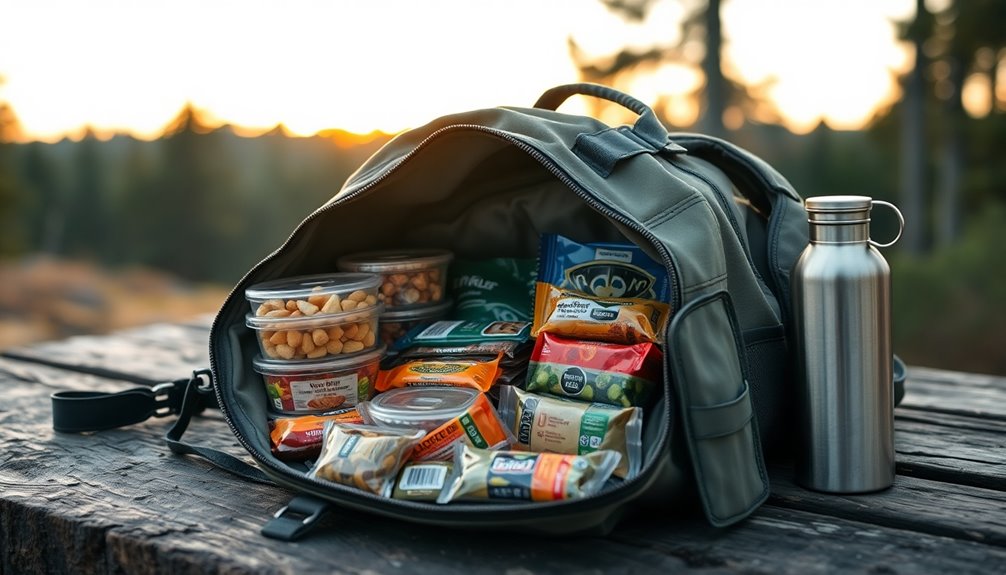
When packing your bug-out bag, consider the essential food types that provide the nutrition you'll need in an emergency. Focus on options that are lightweight and easy to store, ensuring they fit well in your bag without taking up too much space. By selecting the right non-perishable foods, you can maintain your energy and health during challenging times. Including nutrient-rich snacks like energy bars and trail mix offers quick boosts of energy, which is crucial for sustaining your strength in survival situations.
Essential Food Types
While preparing your bug-out bag, it's crucial to include essential non-perishable food options that can sustain you in an emergency. Opting for lightweight, compact foods guarantees you won't be weighed down. Here are four key types to take into account:
- Dehydrated and Freeze-Dried Foods: These meals are easy to prepare by just adding water. Options like instant oatmeal, freeze-dried fruits, and meals from brands like Mountain House are perfect for quick, nutritious sustenance.
- Canned and Pouched Goods: Canned fruits, vegetables, and meats are shelf-stable and can be eaten straight from the can. Small pouches of tuna or chicken are excellent for protein, as they are non-perishable food options with a long shelf life.
- Grains and Pasta: Dry pasta and instant rice are lightweight and filling. They only require boiling water and can be combined with other food items for a complete meal.
- Snacks and Energy Bars: High-calorie energy bars, dried fruits, and nuts provide quick energy. Peanut butter pouches are also a great source of protein.
Including these essential food types in your bug-out bag will help guarantee you stay nourished during emergencies.
Nutritional Considerations
Nutritional considerations are crucial when selecting non-perishable food options for your bug-out bag, as they'll greatly impact your energy and well-being during an emergency. Focus on incorporating a variety of food types to guarantee you meet your nutritional needs.
Start with non-perishable staples like canned goods, which provide convenient and long-lasting options such as fruits, vegetables, and meats. Grains like rice and pasta offer sustained energy, while powdered milk serves as a space-efficient source of vitamins and minerals. Honey can be a sweet addition with an indefinite shelf life.
Don't forget nutrient-rich snacks. Energy bars, trail mix, and dried fruits deliver quick energy and critical carbohydrates. Nuts and seeds are high in fiber and protein, while jerky supplies essential protein without weighing you down. Having a good supply of non-perishable foods is also essential for ensuring you have adequate nutrition during an emergency.
Consider including dehydrated and freeze-dried meals for variety and ease of preparation. Instant noodles and oatmeal require only boiling water, and military MREs offer complete meals in compact packages.
High-protein options like canned tuna, peanut butter, and legumes will keep you feeling full and energized. By choosing wisely, you'll guarantee your bug-out bag fuels your survival effectively.
Packaging and Storage
Packing your bug-out bag with non-perishable food options requires careful attention to packaging and storage to affirm everything remains fresh and accessible during an emergency. Here are four essential tips to take into account:
- Choose lightweight foods: Opt for options like dehydrated meals, jerky, and energy bars that won't weigh you down. Additionally, essential survival gear like lightweight, nutrient-dense food is crucial for maintaining energy levels during challenging situations.
- Use waterproof containers: Store your food in airtight, waterproof containers to protect against spoilage and contamination.
- Prioritize individual packaging: Foods that come in single servings, like energy bars and pouches of nuts, are easy to grab and consume on the go. Additionally, the quality of food impacts your overall energy and survival capability, making it crucial to select nutrient-dense options.
- Organize for accessibility: Arrange your food items in a way that makes them easy to find and use quickly.
Remember to rotate your stock regularly to maintain freshness and keep your supplies safe from extreme temperatures and moisture. By paying attention to these packaging and storage strategies, you'll affirm that your bug-out bag is ready for any situation, keeping you nourished and energized when it matters most.
First Aid and Hygiene Kit
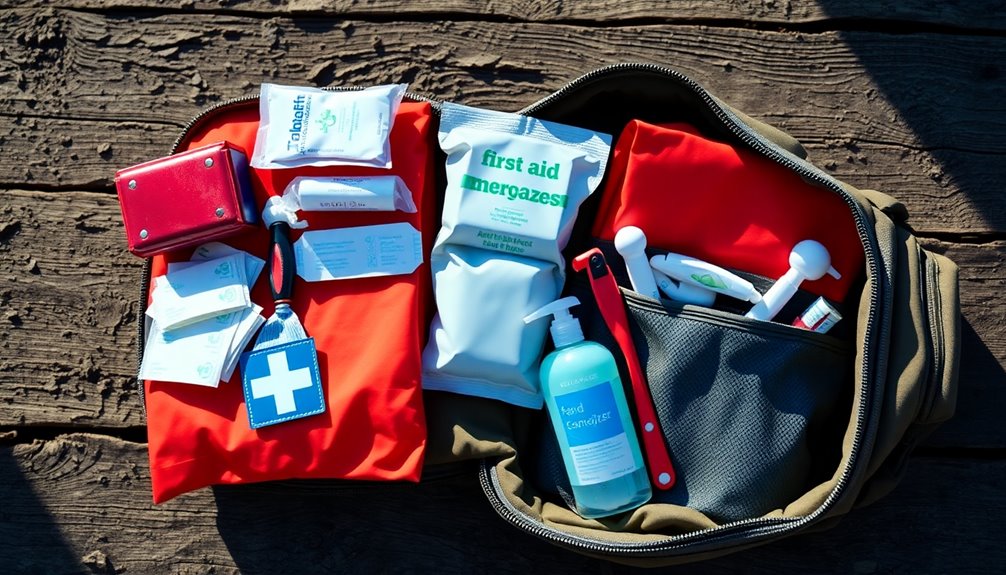
A well-stocked first aid and hygiene kit is essential for any bug-out bag, ensuring you're prepared for minor injuries and maintaining personal cleanliness in emergency situations. Start with basic first aid items like antiseptic wipes, antibacterial ointment, assorted adhesive bandages, and gauze pads in various sizes. Don't forget butterfly bandages or adhesive wound-closure strips for larger cuts. Including BZK-based antiseptic wipes or alcohol-based alternatives can enhance your kit's effectiveness in cleaning wounds.
For trauma and wound care, include a blood clotting agent, a tourniquet, and hemostatic gauze. Triangle bandages are versatile and can assist in several medical situations. A skin closure kit, such as 3M Steri Strip, will help with larger lacerations.
Medications are vital as well. Pack ibuprofen for pain relief, antihistamines for allergic reactions, and anti-diarrheal medicine. If you have severe allergies, an injectable epinephrine can be lifesaving.
In terms of hygiene, bring a toothbrush, soap, and a towel. Keep toilet paper or wipes handy, along with hand sanitizer for cleanliness. Biodegradable soap is a great choice for the environment. This extensive kit will help you stay healthy and safe during emergencies.
Shelter and Sleeping Essentials

After ensuring your first aid and hygiene needs are met, focus on shelter and sleeping essentials to protect yourself from the elements. Your comfort and safety depend on the right gear. Here's what you should pack:
- Tent: Include a waterproof survival tent made of Mylar for heat retention and water repellency.
- Sleeping Bag: Choose a lightweight, insulated sleeping bag suitable for your climate.
- Ground Pad: A foam pad or Therm-a-Rest will provide sleeping comfort and insulation from the cold ground.
- Mylar Blanket: Pack lightweight Mylar blankets for emergency warmth and shelter. Additionally, ensure that your gear includes environmental protection to safeguard against harsh weather conditions.
You might also want a small tarp for added protection or a bivvy sack for extra shelter. Don't forget a rain poncho that can double as a tarp, which is especially useful in wet conditions. If you anticipate colder nights, consider adding a wool blanket for warmth.
Key Survival Tools

While you might think of food and water as your top priorities in a survival situation, the right tools can make all the difference in ensuring your safety and comfort.
First, consider a reliable knife; it's necessary for hunting, cooking, and repairs. Pair it with a hatchet for cutting firewood and building shelter. An axe can be safer than a machete and doubles as a hammer, while a machete serves well for clearing paths. For wood and shelter construction, a Bahco Laplander Folding Saw is invaluable.
Next, fire starting tools are essential. A magnesium striker is compact and works in all weather. Waterproof matches, tinder in a waterproof bag, and firestarters provide reliable ignition sources. A pocket Fresnel lens can harness sunlight to spark a flame. Additionally, having firewood cutting tools can greatly enhance your ability to gather materials for warmth and cooking.
Don't overlook multi-purpose tools. A multi-tool, like a Leatherman, covers various repairs, while duct tape can fix just about anything. A sewing kit will help you mend clothing.
Lastly, navigation tools are crucial. A compass and local maps guide you if GPS fails. Paracord and nylon rope have multiple uses, ensuring you're prepared for a variety of tasks.
Communication Devices
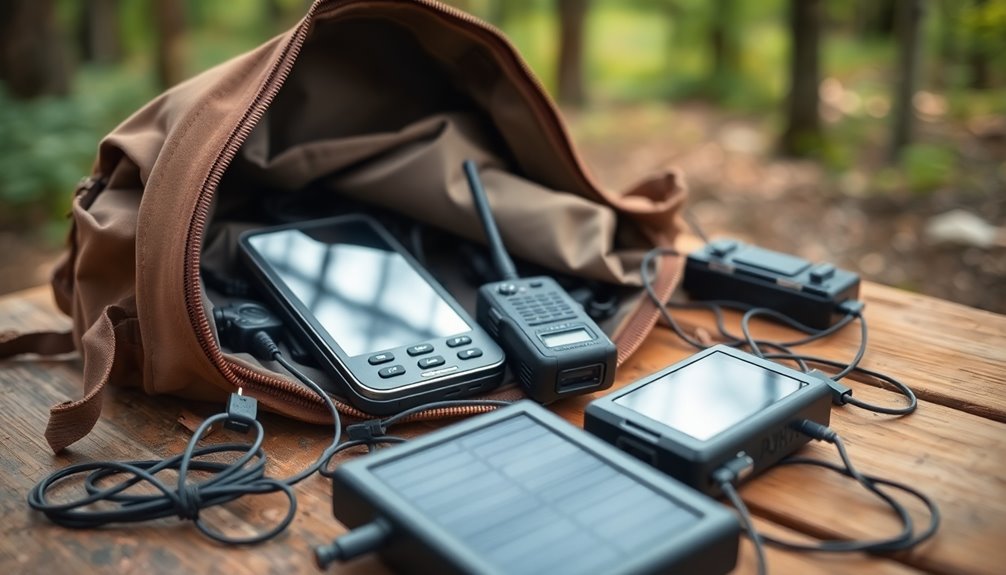
When you're planning your bug-out bag, including essential communication tools is vital. Whether you opt for walkie-talkies, CB radios, or more advanced devices, having reliable ways to stay in touch can make all the difference. Don't forget to take into account emergency signal methods as well, so you can communicate your needs even in the toughest situations. Having a backup plan for alternative communication is crucial, especially during crises when traditional methods may fail.
Essential Communication Tools
Effective communication is vital in any emergency situation, and having the right tools can make all the difference. To guarantee you stay connected, consider including the following vital communication tools in your bug-out bag:
- Handheld Radios: Lightweight models, like Baofeng, are perfect for local communication. Opt for waterproof versions that meet MilSpecs, and make sure they can use AA battery packs for versatility.
- Two-Way Communication Devices: Walkie-talkies allow group members to stay in touch if separated. Hand-cranked or solar-powered radios can be lifesavers when conventional communication fails.
- Written Communication Tools: Water-resistant note pads and Fischer Space Pens are essential for leaving messages. These pens work in any condition and guarantee your notes withstand the elements. Additionally, consider including all weather notebooks to ensure your written messages remain legible even in wet conditions.
- Broadcast and Receive Devices: Battery or hand-cranked radios can help you stay updated on emergency broadcasts. Also, consider solar-powered lanterns or glowsticks for signaling in low visibility.
Emergency Signal Methods
In emergencies, having reliable signal methods can be the difference between being found and remaining lost. Pack an emergency whistle like the UST JetScream in your bug-out bag. It's loud, durable, and can be heard from many meters away. Remember to use the standard distress signal: three long blasts to indicate distress and one blast to confirm you're heard.
A signal mirror is another essential tool. Capable of being seen from up to 100 miles away, it allows you to send Morse code signals like "SOS." This lightweight, battery-free device is easy to carry and incredibly effective.
Additionally, consider visual signaling tools like glowsticks or space blankets. Glowsticks can attract attention when left on roofs, while space blankets reflect light. A tarp can also serve as a signaling device when displayed prominently.
Don't overlook two-way radios and emergency radios for communication. They help coordinate efforts and provide weather updates. Make sure to establish a communication plan and keep your devices in protective pouches, ensuring they're ready when you need them most. These signal methods can greatly improve your chances of rescue in a crisis. Having a well-rounded bug out bag with essential tools can also enhance your preparedness for emergencies.
Cooking and Food Preparation
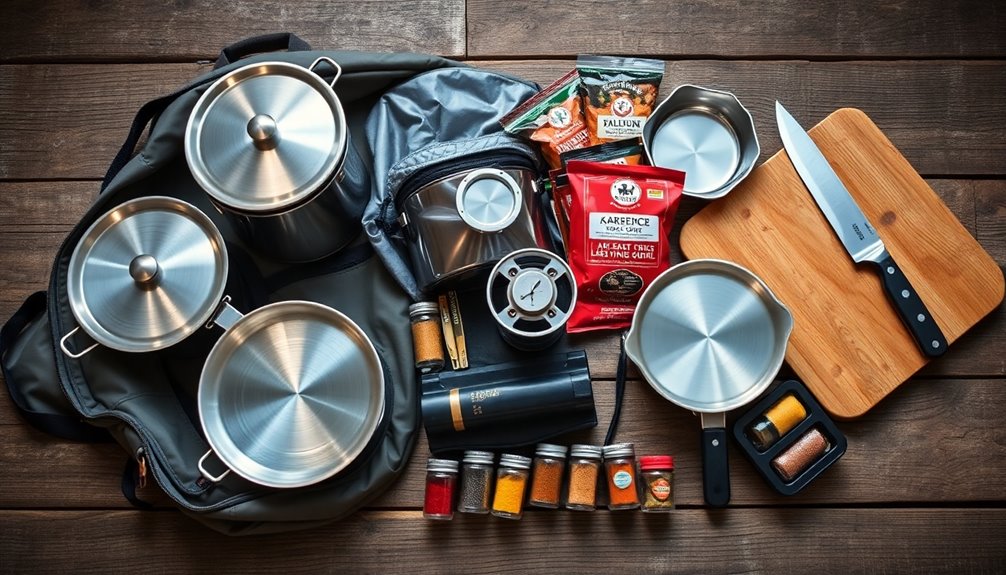
Cooking and food preparation are essential skills for any bug-out scenario, ensuring you can sustain yourself in the wild. To effectively cook and prepare food, make sure you pack the right equipment and supplies. Here's a quick list of must-have items:
- Cooking Equipment
- Portable stove
- Cooking pots and pans
- Fuel for the stove (butane, white gas, or propane)
- Food Supplies
- Freeze-dried meals for variety
- Non-perishable staples like rice and pasta
- High-protein snacks such as beef jerky
- Food Preparation Tools
- Matches or fire starters
- Can opener for canned goods
- Portable cook kit with pot support
- Miscellaneous Items
- Ziplock bags for food storage
- Water purification tablets
- Paracord for securing equipment
With these essentials in your bug-out bag, you'll be prepared to prepare meals and stay nourished, even in challenging conditions. Prioritize lightweight and compact items, as space is often limited in a bug-out scenario. Additionally, remember the importance of food preservation to extend the shelf life of your supplies and ensure you have enough to sustain yourself during emergencies.
Personal Safety Gear
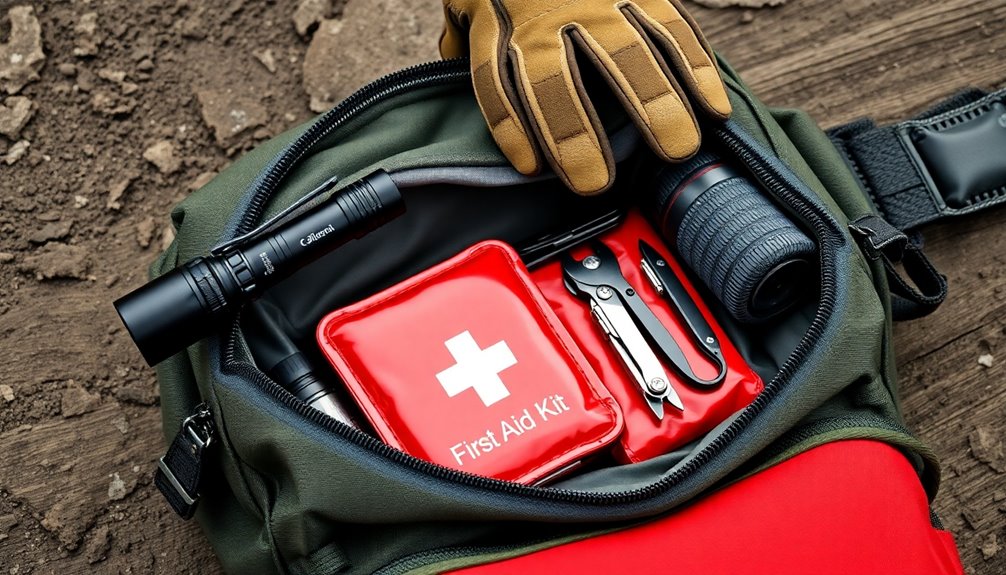
When facing uncertain situations, having the right personal safety gear is vital for your protection and peace of mind. Start by including self-defense tools like pepper spray, a Taser, or mace, depending on local laws. A reliable knife, such as the ESEE 4P Survival Knife, can also be invaluable. Consider adding a crossbow with bolts or a bow and arrows for more versatile defense options.
Protective gear is equally important. Pack a respirator or gas mask, and don't forget an N95 face mask to shield against airborne threats. Ballistic protection, such as an armor vest or bulletproof backpack insert, can offer added security. Safety glasses or goggles protect your eyes, while ear plugs help maintain your hearing in chaotic environments. Additionally, having an essential air filtration mask is crucial for maintaining safe breathing in contaminated environments.
Don't overlook personal security documents. Keep copies of your identification, insurance cards, and emergency contacts in waterproof bags. Include important documents like house deeds and car titles to guarantee you have what you need in a pinch.
Additional Gear and Supplies

Packing your bug-out bag with additional gear and supplies can greatly enhance your preparedness for any emergency. Consider including the following essential tools and equipment to guarantee you're ready for anything:
- Leatherman Multitool – Versatile for various tasks, making it indispensable.
- Ferrocerium Rod – Helps you start fires easily in any weather.
- Bahco Laplander Folding Saw – Perfect for cutting wood and other materials.
- Military Can Opener (P-51 Shelby Opener) – A must for opening canned goods efficiently.
Don't overlook hygiene and sanitation items. Keeping clean is crucial, so pack hand sanitizer, a toothbrush, toothpaste, and all-purpose camp soap. Also, include toilet paper and a portable bidet for personal hygiene. Including water purification methods ensures that you have access to safe drinking water during emergencies.
For shelter and protection, a waterproof tarp, survival bivy, poncho, and small tent will keep you safe from the elements. Finally, don't forget navigation and communication tools. Maps, a compass, and a reliable ham radio can help you find your way and stay connected.
Frequently Asked Questions
How Often Should I Update My Bug-Out Bag Supplies?
You should update your bug-out bag supplies regularly, ideally every season. Check for expired items, inspect gear for wear and tear, and replace anything damaged. If your health changes or family dynamics shift, adjust your supplies accordingly. Pay attention to local environmental threats and modify your gear as needed. Regular inspections keep everything usable, so make it a habit to reassess your bag to guarantee you’re always prepared. Consider adding urban bug out bag essentials such as a map of your city, a multi-tool, and portable water purification. These items can be critical if you need to navigate through a city or deal with urban hazards during an emergency. By regularly updating and customizing your bug-out bag, you can ensure that you have the necessary supplies to handle any situation, no matter where you find yourself.
What Is the Ideal Weight for a Bug-Out Bag?
Imagine lugging around a bag that feels like a boulder—definitely not ideal! For your bug-out bag, aim for a weight between 20 to 25 pounds, but keep it under 30 for comfort. Remember, heavy loads can slow you down and lead to injuries. Prioritize essential items and consider lighter gear to keep your mobility intact. Test your bag regularly to guarantee it feels like a feather, not a mountain!
Can I Use Everyday Items Instead of Specialized Gear?
Absolutely, you can use everyday items instead of specialized gear! Things like a sturdy backpack, water bottles, and a basic first aid kit can work just as well. A bandana can serve multiple purposes, like a dust mask or a tourniquet. Plus, items like a flashlight, a multi-tool, and even your clothing can be repurposed for survival. Get creative with what you have; it can be just as effective!
How Do I Choose the Right Backpack for My Bug-Out Bag?
When choosing the right backpack for your bug-out bag, focus on durability and organization. Look for heavy stitching, robust zippers, and water-resistant material to guarantee it withstands tough conditions. A roomy design with multiple pockets allows for easy access to your gear. Comfort is key, so opt for padded straps and a hip belt for weight distribution. Additionally, consider features like MOLLE compatibility and hydration systems to enhance functionality.
What Are the Best Storage Methods for Food Supplies?
To store food supplies effectively, use airtight and waterproof containers to keep everything dry. Ziplock or resealable bags work great for individual items. For space efficiency, pack food in a stainless steel pot or organize similar items together. Keep heavier items at the bottom of your backpack and use external pockets for easy access. Don't forget to confirm your backpack is water-resistant to protect your supplies from moisture.
Conclusion
As you prepare your bug-out bag, think of it as your lifeboat in a stormy sea. Each item you pack is a crucial piece of that vessel, ready to keep you afloat when the unexpected hits. From essential clothing to hydration supplies, every choice matters. Don't underestimate the importance of being equipped; your survival could depend on it. So, gather your gear and set sail with confidence, knowing you're ready for whatever waves come your way.



